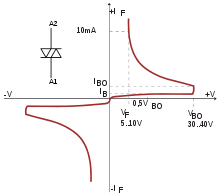Current–voltage characteristic

A current–voltage characteristic or I–V curve (current–voltage curve) is a relationship, typically represented as a chart or graph, between the electric current through a circuit, device, or material, and the corresponding voltage, or potential difference across it.
In electronics

In electronics, the relationship between the direct current (DC) through an electronic device and the DC voltage across its terminals is called a current–voltage characteristic of the device. Electronic engineers use these charts to determine basic parameters of a device and to model its behavior in an electrical circuit. These characteristics are also known as IV curves, referring to the standard symbols for current and voltage.
In electronic components with more than two terminals, such as vacuum tubes and transistors, the current-voltage relationship at one pair of terminals may depend on the current or voltage on a third terminal. This is usually displayed on a more complex current–voltage graph with multiple curves, each one representing the current-voltage relationship at a different value of current or voltage on the third terminal.[1]
For example the diagram at right shows a family of IV curves for a MOSFET as a function of drain voltage with overvoltage (VGS − Vth) as a parameter.
The simplest IV characteristic involves a resistor, which according to Ohm's Law exhibits a linear relationship between the applied voltage and the resulting electric current. However, even in this case, environmental factors such as temperature or material characteristics of the resistor can produce a non-linear curve.
The transconductance and Early voltage of a transistor are examples of parameters traditionally measured with the assistance of an I–V chart, or laboratory equipment that traces the charts in real time on an oscilloscope.
Special I-V curves characteristics
- IV curve may be non-monotonic: for example a tunnel diode has a negative resistance region.
- IV curve isn't necessarily a mathematical function: for example a DIAC or a spark gap starts to conduct electrical current only after its breakover voltage is exceeded
- IV curve may be directional or may have hysteresis: for example Memristor and Gunn diode
 IV curve similar to a tunnel diode characteristic curve. It has negative resistance in the shaded voltage region, between v1 and v2
IV curve similar to a tunnel diode characteristic curve. It has negative resistance in the shaded voltage region, between v1 and v2 DIAC IV curve. VBO is the breakover voltage.
DIAC IV curve. VBO is the breakover voltage. Memristor IV curve, showing a pinched hysteresis
Memristor IV curve, showing a pinched hysteresis Gunn diode IV curve, showing negative differential resistance with hysteresis (notice arrows)
Gunn diode IV curve, showing negative differential resistance with hysteresis (notice arrows)
In electrophysiology

While V–I curves are applicable to any electrical system, they find wide use in the field of biological electricity, particularly in the sub-field of electrophysiology. In this case, the voltage refers to the voltage across a biological membrane, a membrane potential, and the current is the flow of charged ions through channels in this membrane. The current is determined by the conductances of these channels.
In the case of ionic current across biological membranes, currents are measured from inside to outside. That is, positive currents, known as "outward current", corresponding to positively charged ions crossing a cell membrane from the inside to the outside, or a negatively charged ion crossing from the outside to the inside. Similarly, currents with a negative value are referred to as "inward current", corresponding to positively charged ions crossing a cell membrane from the outside to the inside, or a negatively charged ion crossing from inside to outside.
The figure to the right shows an V–I curve that is more relevant to the currents in excitable biological membranes (such as a neuronal axon). The blue line shows the V–I relationship for the potassium ion. Note that it is linear, indicating no voltage-dependent gating of the potassium ion channel. The yellow line shows the V–I relationship for the sodium ion. Note that it is not linear, indicating that the sodium ion channel is voltage-dependent. The green line indicates the I–V relationship derived from summing the sodium and potassium currents. This approximates the actual membrane potential and current relationship of a cell containing both types of channel.
References
| Wikimedia Commons has media related to Device current-voltage characteristics. |
- ↑ H. J. van der Bijl (1919). "Theory and Operating Characteristics of the Themionic Amplifier". Proceedings of the IRE. Institute of Radio Engineers. 7 (2): 97–126. doi:10.1109/JRPROC.1919.217425.